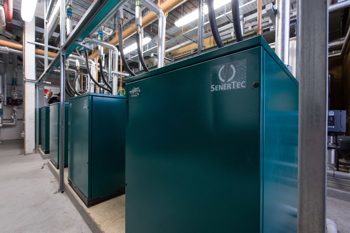CHP to help create a greener NHS

The UK's healthcare sector spends more than £400 million a year on energy so it’s no wonder that the NHS takes the issue of energy efficiency very seriously. Plans to create a more sustainable NHS can deliver more-energy-efficient estates and deliver savings that can be reinvested into frontline services at a time when budgets are being squeezed. Gary Stoddart of Remeha looks at the role CHP has to play in giving the NHS a cleaner bill of health.
Without additional funds coming into the NHS, one way to boost budgets is to save money — and improvements to energy efficiency can make a huge difference. According to the Building Research Establishment (BRE), 20% of energy is wasted by health services,* with building functions such as heating, hot-water production and ventilation contributing to this waste.
Some steps have already been taken to reduce energy waste and make the NHS more efficient, in the form of the Department of Health’s NHS Energy Efficiency Fund. The objective of the fund is to reduce NHS estate operating costs by investing in selected energy-efficiency projects and reinvesting savings back into frontline care.
But what energy-efficiency projects are right for the NHS and its estate? To assist NHS providers, the Securing Healthy Returns report was published earlier this year by NHS England and Public Health England. The report analysed sustainability measures that it says could achieve a total £400 million of cost savings, covering everything from new technology to staff education.
Of the 18 energy-saving measures analysed in the report, CHP was named as the biggest energy saving opportunity for the NHS. It has the potential to save the health service £26.4 million every year — enough to fund the salaries of more than 1200 newly qualified nurses.
In terms of potential cost savings, CHP was ranked above staff energy awareness and behavioural change (£21.5 million). It was also deemed significantly more effective than high-efficiency lighting (£7.2 million) and reducing temperature set points by 1 K (£6.2 million). It also boasts significant energy savings, with CHP having the potential to cut carbon dioxide emissions by 3750 t a year across the NHS. This is the equivalent of taking 1250 cars off the road or the carbon-dioxide offset of a forest more than three times the size of Sherwood Forest.
These phenomenal savings can be achieved because on-site CHP is about 30% more efficient than relying on traditional heating plant and electricity supplied solely from the grid. And it costs three or four times less.
CHP is great for buildings with high and continuous year-round heating loads like hospitals; because of the long running hours, these buildings can achieve the most energy-efficient operation.
It’s worth noting that savings can only be achieved when the CHP unit is sized correctly. Oversized CHP units are not able to run if the heat demand is not present, and as a result the anticipated electricity will not be generated. The golden rule for CHP is to keep it as small as possible. The system should be sized so that the base-load heating requirements can be met largely by the CHP unit alone. This will result in the continuous generation of low-cost low-carbon electricity as a by-product of producing base-load heating.

The best way to ensure that CHP works as intended and delivers maximum savings is for heating engineers to be included in the conversation from the outset of a project so they can feed in the necessary information to ensure the right solution is chosen.
For Remeha our involvement doesn’t stop at selling a CHP unit; we offer a range of maintenance and monitoring solutions, meaning we can work with a building operator post-installation to ensure the system runs efficiently and continues to deliver reductions in costs and carbon emissions.
Remeha has recently expanded its CHP range to include the Dachs Mini-CHP 5.5 kW(e) previously sold by its sister company SenerTec. It has also brought in SenerTec’s team of CHP experts to oversee projects such as installing CHP in healthcare facilities, to ensure that the technology can deliver maximum savings.
CHP is a well-established, proven, reliable technology with numerous successful installations throughout the world, including hospitals across the UK. It should be an important consideration for any hospital looking to replace their heating system.
Gary Stoddart is technical sales director at Remeha.
* http://www.bre.co.uk/page. jsp?id=2627







